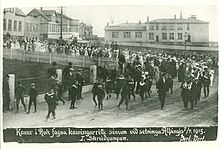 A procession in Bankastræti in Reykjavík on July 7th 1915 to celebrate women's suffrage. | |
| General Statistics | |
|---|---|
| Maternal mortality (per 100,000) | 27[1] |
| Women in parliament | 38%[2] |
| Women over 25 with secondary education | 99% [M: 99%] |
| Women in labour force | 79% [M: 86%][2] |
| Gender Inequality Index[3] | |
| Value | 0.043 (2021) |
| Rank | 8th out of 191 |
| Global Gender Gap Index[4] | |
| Value | 0.908 (2022) |
| Rank | 1st out of 146 |
| Part of a series on |
| Women in society |
|---|
 |
Women in Iceland generally enjoy good gender equality. As of 2018, 88% of working-age women were employed, 65% of students attending university were female, and 41% of members of parliament were women. Nevertheless, women still earn about 14% less than men,[5] though these statistics do not take into account the hours worked, over-time, and choices of employment.[6] There is also the problem of younger women potentially out-earning men due to policies that are supposed to decrease the gender wage gap.[7] Iceland has the world's highest proportion of women in the labour market and significant child care allocations for working women.[8] It has gender neutral parental leave, with a quota for each parent, and a transferable part.[9]
Iceland is arguably one of the world's most feminist countries, having been awarded this status in 2011 for the second year in a row.[10] Iceland was the first country to have a female president, Vigdís Finnbogadóttir, elected in 1980.[11] It also has the world's first female and openly gay head of government, Jóhanna Sigurðardóttir, who was elected prime minister in 2009.[12]
Iceland enjoys the smallest overall gender gap, according to the World Economic Forum ranking Global Gender Gap Report, a position it has held since 2009. In 2020 Iceland had a 12.2% gap, as measured across four categories: health, education, economic participation and opportunity, and political advancement. The pay gap between women and men is decreasing at a rate which would lead to parity in 2068.[13] Women earn about 72% of men's salaries on average, and are still subject to domestic and sexual violence.[8] Women in Iceland do not necessarily fare better than other countries in professional fields: for example Iceland's percentage of female medical doctors is one of the lowest within the OECD (only Japan, Korea, Luxembourg and the US have less female doctors).[14]
- ^ Birgisdottir, Hera; Bjarnadottir, Ragnheidur I.; Kristjansdottir, Katrin; Geirsson, Reynir T. (2016). "Maternal deaths in Iceland over 25 years". Acta Obstetricia et Gynecologica Scandinavica. 95 (1): 74–78. doi:10.1111/aogs.12797. PMID 26459287. S2CID 1427445.
- ^ a b "Statistics Iceland: Educational attainment of women and men differs by region". Statistics Iceland. Retrieved 3 September 2018.
- ^ "Human Development Report 2021/2022" (PDF). HUMAN DEVELOPMENT REPORTS. Retrieved 6 October 2022.
- ^ "Global Gender Gap Report 2023" (PDF). World Economic Forum. Retrieved 17 January 2023.
- ^ "Iceland: Top for equality but still 'needs to do more'". BBC News. 2016-12-07. Retrieved 2024-04-09.
- ^ "Are women paid less than men for the same work?". The Economist. ISSN 0013-0613. Retrieved 2024-04-09.
- ^ Fry, Richard. "Young women are out-earning young men in several U.S. cities". Pew Research Center. Retrieved 2024-04-09.
- ^ a b "The Iceland women's strike, 1975". libcom.org. Retrieved 2016-12-09.
- ^ "Iceland".
- ^ "Economies". Global Gender Gap Report 2015.
- ^ Disill. "Vigdís Finnbogadóttir". english.forseti.is. Archived from the original on 2015-02-04. Retrieved 2016-12-09.
- ^ "Johanna Sigurdardottir | prime minister of Iceland". Encyclopædia Britannica.
- ^ Cite error: The named reference
:4was invoked but never defined (see the help page). - ^ "Data - OECD".
© MMXXIII Rich X Search. We shall prevail. All rights reserved. Rich X Search
